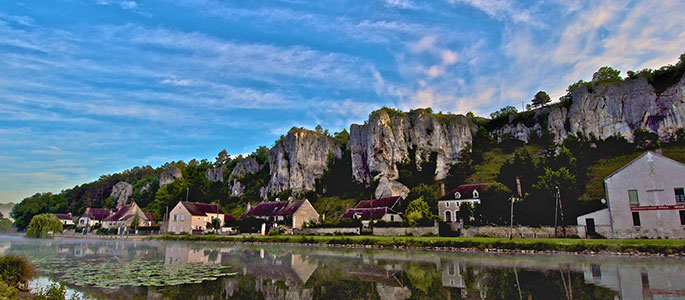Advertisement
Liberté, Egalité, Fraternité Afloat
French Canals
By Bernadette Bernon
For years I'd dreamed of taking a barge vacation through the French canals. I'd imagined lingering in picturesque countryside villages, browsing the open-air summer food markets with a basket on my arm that was full of the gastronomical treasures I'd selected for our lunch. I'd imagined sampling the artisan cheeses and ogling the massive selection of olives and mushrooms and pâté and breads, then climbing back aboard our cozy vessel as we pushed off to languorously putter on the canal through the stunning farming valleys, passing whitewashed cottages, with their colorful wood shutters and overflowing flowerboxes. But there was a snag. My husband Douglas didn't share this dream. Actually, that's an understatement; he thought crawling through France at four knots on a fussy barge full of strangers would be a little slice of hell on earth.
Luckily, we have good friends who talked him into it, promising that we'd cycle and hike every day, that we'd unabashedly overdose on the finest food and wine in France — but on our own terms, and without spending a fortune. The key? We'd charter a modern 42-foot fiberglass self-drive barge, have it all to ourselves, and be free to do as we pleased ... and that's what happened. Last June, with our friends, we embarked on what would be one of the best holidays of our lives exploring the Canal du Nivernais.

A Le Boat self-drive barge meanders down the Canal du Nivernais, with a bike path along its banks, and vistas and historic buildings around every turn. (Photo: Douglas Bernon)
Sitting on the top deck, we watched the wildflowers and grasses undulating in the breeze, and took turns driving as our barge slowly made the gentle arcs that introduced around each bend one vista more stunning than the next. Every hour or two, we came to a lock with massive metal doors that opened like the gates of heaven. We'd enter and tie up inside as each unfailingly charming and friendly lockkeeper turned the manual gears that closed the gates behind us. Next he'd open the valves to allow the water to rush in, raising the boat until we were up to the level of the water ahead; then he'd rush to the front, open those gates, tip his hat, and out we'd pop, into another gorgeous setting.
The food was out of this world, and it did seem sometimes that we were eating our way through Burgundy. But we had loads of exercise every day, and refused to worry about it. The canal system was once the main commercial transportation system linking the towns of France. They're wide and deep all the way to the sides, with solid-rock walls, and — the best part — alongside them are bike paths! In the old days, horses pulled commercial barges full of lumber and supplies; today those paths remain, but they're paved, wide, and flat! Our boat was equipped with bikes, and as long as two people stayed onboard to negotiate the locks, we could cycle to the next town, or through the countryside. We'd stop for café au lait when we liked, or to pick fruit — it was cherry and raspberry season — or just to sit on the banks and watch the world go by, trying to decide in which gem of an antique town we might pause for the evening, until our friends came 'round the bend and we jumped back aboard.
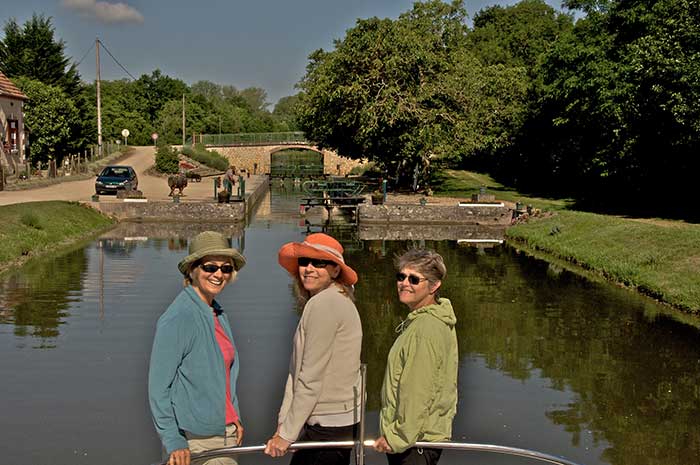
Approaching a lock with a view from the best seat in the house. (Photo: Bernadette Bernon)
On one of my favorite evenings, we just pulled over to the side of the canal, where the scene was magically lit under a full moon, and the little town in the distance was from a picture postcard. Each barge comes with a sledgehammer and a couple of picks, which you just tap into the ground and tie to on those days where you want to forgo the village bustle for some solitude; docking all along the canals is free. The locks close at 6, so there's zero traffic in the evenings. That night, on our dining table were mouthwatering fresh foods from the day's markets, delicious wines from the region — inexpensive, yet some of the finest we've ever had. My dream had come true, and it was a more stunning — and more affordable — voyage than we'd ever imagined. Douglas has been talking about going back.
Logistics:
- Fly to Paris, take the train directly from the airport to Migenne, where you can provision, pick up the boat, and take off the same day.
- On the return, after turning the boat in by noon, simply take the afternoon train back to the Paris airport, and fly home that night.
- A few days spent in Paris are a delight, but if time or budget is a concern, there's no need to stay over in the city; trains are plentiful and run regularly.
Planning:
- Le Boat's fleet of self-drive barges is in terrific condition; the boats come in many sizes, and are absolutely simple and fun to operate. There are governors on the engines that won't allow them to travel at more than 5 knots, and thick integral bumpers all around the hulls so that you can kiss the sides of locks without worry.
- Most French locks are operated by full-time lockkeepers, some of whom even live on site with their families, and who are all super-helpful and friendly. The one-week charter described here was on a 42-footer that slept four couples. In June, before school vacation began in Europe, the canals were peaceful and unhurried.
- A three-cabin, three-head barge on the Canal du Nivernais, for a week in June, is $3,766.50. In June, before school vacation began in Europe, the canals were peaceful and unhurried.
Billfishing At Its Best
Casa Vieja Lodge, Puerto San Jose, Guatemala
By Pat Ford
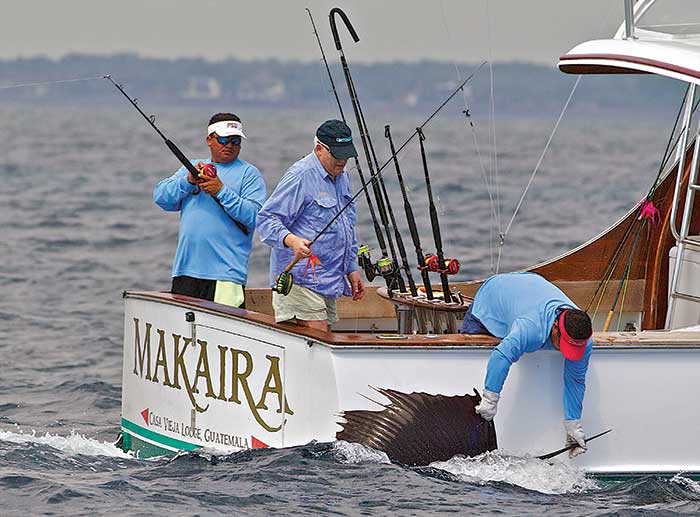
Every day is all about fishing at the Casa Vieja Lodge. These guests on Makaira, the resort's boat, land a sailfish. (Photo: Pat Ford)
After traveling around the globe chasing exotic fish, I can safely say the Casa Vieja Lodge in Guatemala has to be at the very top of my list for anyone who wants to catch a sailfish on a fly or just pull in big Pacific sails all day long. Peak season is December through March and it's not uncommon to raise 30-plus sailfish in a day. Most are teased up to the transom with hookless baits so the angler can throw a fly or pitch a ballyhoo, which results in a hook-up 30 feet behind the boat, and that makes for spectacular jumps.
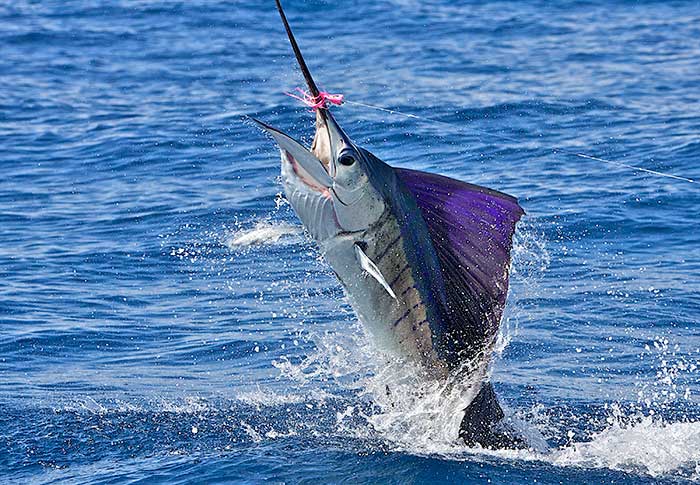
Sailfish are spectacular leapers, often performing acrobatic displays just feet from the stern. (Photo: Pat Ford)

This one is tail-walking away from the mate who’s got the leader in hand. (Photo: Pat Ford)
The boats, mostly 37- to 40-foot sportfishers, carry all the tackle, baits, lures, and/or flies that you'll ever need, and they fix a hot lunch every day. There's always the chance that a blue marlin will come into the spread and there's no place better on earth to catch a blue marlin on fly. Jake Jordan runs several fly-fishing schools each year as well as a fly tournament every January. If you can't make Jake's tournament, Hall of Fame angler Stu Apte, who has held 44 light-tackle and fly-fishing world records, also has one in late January.
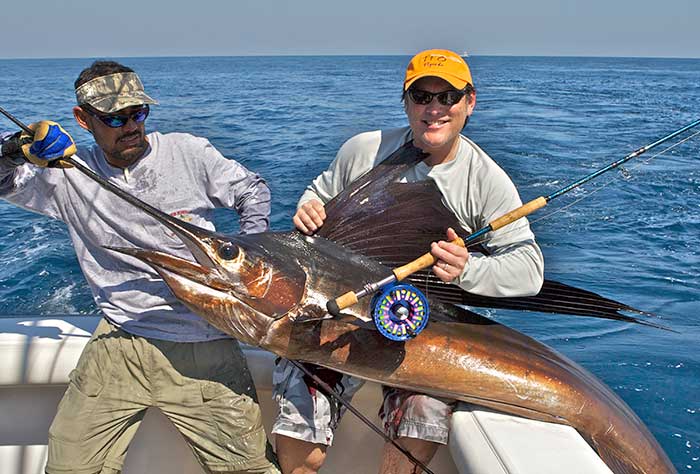
Catch and release means you get to go home with a great photo, and the fish goes back in the water. (Photo: Pat Ford)
The fact that these two fly-fishing legends picked Casa Vieja Lodge to host their operations says it all. It has everything you'll need and it's first class — the staff, chef, beds, and especially the bar. My week there was one of the best fishing trips I've ever experienced.
Logistics:
- It's about a two-hour flight from Miami to Guatemala City.
- Guests are picked up at the airport in Guatemala City for the 90-minute drive through the mountains to the Pacific coast city of Puerto San Jose.
Planning:
- Packages include all airport and daily transfers to the marina, fishing aboard the lodge's boats with all tackle provided, meals at the lodge and onboard, and non-alcoholic beverages.
- Packages for four nights/three days start at $4,140 each for two anglers. Peak season is December through April. For more info, visit the Casa Vieja Lodge website.
Hideaway of the Gods
The Greek Islands
By Lynda Morris Childress
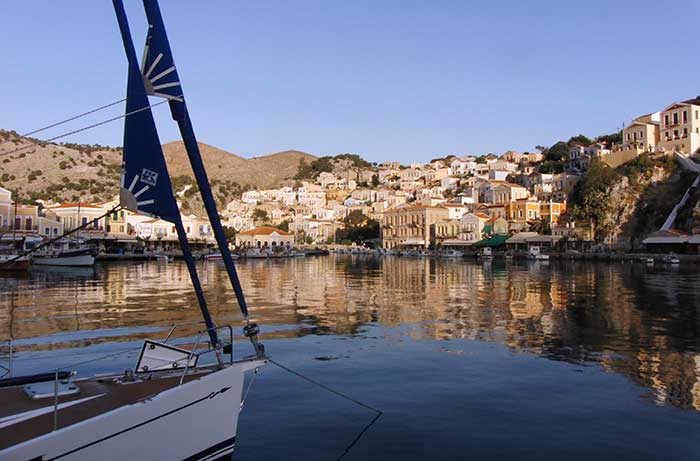
A peaceful morning in scenic Symi Harbor. (Photo: Lynda Morris Childress)
When the chance to charter for 10 days in the Greek isles came my way more than a decade ago, I'd already chartered in most of the world's top spots as a boating journalist, and never dreamed that this country would change my life. To my astonishment, I discovered a small but beautiful country with more than 1,000 islands, a stunning coastline, and a distinctly nautical focus, shaped by a warm climate, excellent breezes, and azure seas. Mountains towered above the ocean, and the terrain changed from verdant to stark as we sailed between islands. History and an ancient culture lurked behind the beauty. The island people were warm-hearted and welcoming; the native cuisine, sublime. After a few days, I was hooked.
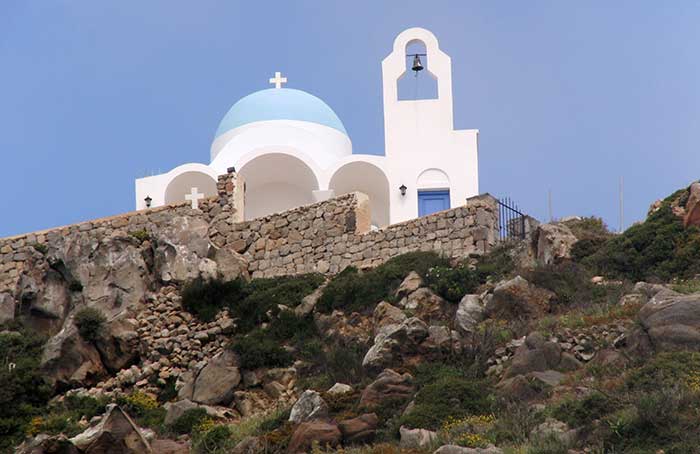
A hilltop church in Nisiros. (Photo: Lynda Morris Childress)
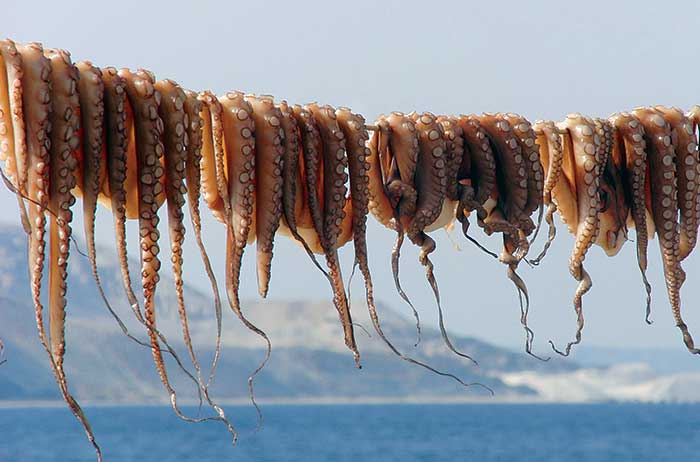
Drying octopuses awaiting the dinner hour. (Photo: Lynda Morris Childress)
That first charter was an exploration of the blue and whitewashed Cyclades Islands, in the center of the Aegean — the popular Mykonos and Santorini, along with lazy, hidden islands, each with its own unique charm. We spent each day sailing, with stops for swimming in the warm, clear sea; then Med-moored in late afternoon at a new island town to explore archaeological sites, meander through villages, or relax in the cockpit or at a seaside café over a cool drink or a taverna meal. During that 10-day sail, I also discovered a soul mate: a Greek captain who shared my love of the boating life.
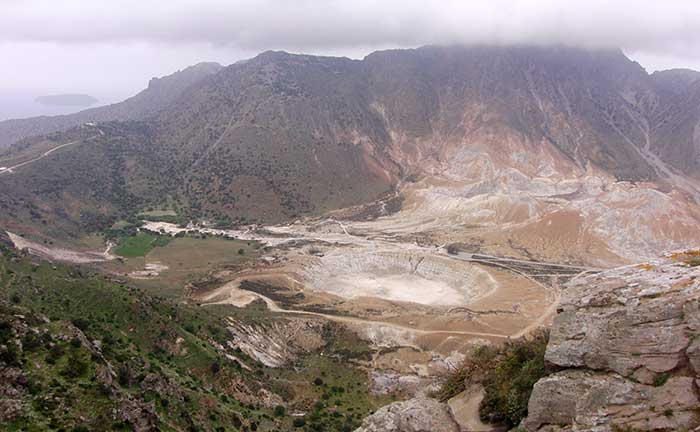
The Nisiros volcano and it's hydrothermic crater. (Photo: Lynda Morris Childress)
I returned to Greece many times after that, and the skipper and I logged thousands of Aegean Sea miles, from the Saronic Islands and Peloponnese coast in the west, to the beautiful Dodecanese Islands in the east. Six years later, we married. Naturally, we bought a boat. We now have a small charter company, and sail the Greek Islands each season, sharing our favorite places with guests aboard our Atlantic 70, Stressbuster. A recurring question our guests always ask is: What's your favorite island? There are so many, and they're all so different. However, my favorites are not the places known by most visitors to Greece, such as Mykonos and Santorini, both of which are beautiful, but expensive and crowded. Some of my favorites are off-the-beaten-path coastal places such as the tiny village of Yerakas on the Peloponnese peninsula, which lies at the end of Greece's only fjord; and Monemvasia, also on the Peloponnese, a majestically restored Byzantine town that's one of the most beautiful but unknown places in Greece. Finally there's Leonidion (Plaka) — like Yerakas, a quintessential Greek village, with a beautiful swimming beach near the harbor.
In the islands, Hydra in the Saronics — the island of the glitterati — is my pick. It's busy, but there are no cars or motorbikes; transportation is by donkey or water taxi only. Its cobbled streets, sea captains' homes surrounding the harbor, winding paths, and windmills are something to experience. Dokos, a tiny, nearby deserted islet (not in the guidebooks!), is wonderful for anchoring off, swimming, hiking, and barbecuing. In the Cyclades, Paros is one of my favorites. The port of Paroikia is busy during summer, but Paros has variety: Along with this bustling Cycladic town, there are quieter villages, amazing beaches, and scenery. Deserted Rinia (also not in guidebooks) is ideal for a beach barbecue, snorkeling, and swimming. In the Dodecanese, Patmos Island (where St. John wrote The Book of Revelations' Apocalypse, and Nisiros (home to a sleeping volcano) are highlights. To find your favorites, you must sail in Greece yourself! No matter how many times you return, there will always be new discoveries.
Logistics:
- It's possible to sail from April to November, but the ideal months are May to September.
- The busiest month is August, when Europeans vacation en masse.
- Greece isn't for the novice bareboater; the seasonal wind called meltemi can sometimes blow Force 8 or 9, the islands are farther apart than those in the popular Caribbean, and there are few aids to navigation except at port entrances.
- You'll need a working knowledge of Med-mooring — docking stern-to at town quays, often in crosswinds, with other boats close by. If you're unsure, opt for a crewed charter, or hire a skipper for one or two days.
- The Moorings, Sunsail, and Istion are three reputable bareboat companies with bases in Greece. All also offer crewed options. A three-cabin bareboat in Greece in June is about $3,213.
- Contact Moorings, Sunsail, Istion, and for info on sailing aboard Sressbuster, visit the Greece Sailing Charters website.
Planning:
- The Aegean is vast, so keep distances in mind.
- If you're starting your sailing charter in the Athens area, where most companies are based, and you only have one week, you'll sail either the Saronic Islands and Peloponnese coast or the Cyclades.
- If you have longer, or a company has bases elsewhere, the Dodecanese, the Ionian, the Sporades Islands, or combining island groups, are also options.
- Wherever you choose, don't try to see too much in too little time. Allow time to linger and venture beyond the ports. You won't be sorry!

